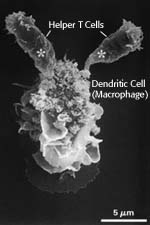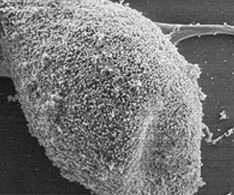Immunology and HIV
Immune system's response to HIVHIV is stopped by innate defenses. HIV cannot penetrate unbroken skin. HIV is transmitted through direct exchange of body fluids. Sexual intercourse is the most common mode of transmission. Blood to blood contact, such as through sharing needles for intravenous injection or blood transfusion can also transmit HIV. Infected mothers can pass HIV to their infants during pregnancy, birth and breastfeeding. Additional information about HIV transmission
HIV mediated disease
Infected cells produce massive amounts of virus
Cellular immune responses to HIV
Why are CD4+ T cells depleted by HIV?
|
Impacts | Immume response | Immunology and HIV | Treatment | Test yourself
The Biology Project
The University of Arizona
Friday, May 5, 2000
Contact the Development Team
http://www.biology.arizona.edu
All contents copyright © 2000. All rights reserved.



